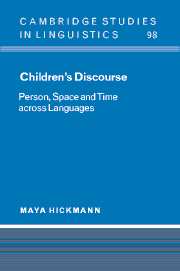Book contents
- Frontmatter
- Contents
- List of figures
- List of tables
- Preface
- List of abbreviations and conventions
- 1 Introduction
- Part I AVAILABLE THEORIES AND DATA
- Part II A CROSS-LINGUISTIC STUDY OF CHILDREN'S NARRATIVES
- 7 Methodological issues
- 8 Animate entities
- 9 Space
- 10 Time
- 11 Conclusions
- Appendix
- Notes
- References
- Author index
- Subject index
10 - Time
from Part II - A CROSS-LINGUISTIC STUDY OF CHILDREN'S NARRATIVES
Published online by Cambridge University Press: 22 September 2009
- Frontmatter
- Contents
- List of figures
- List of tables
- Preface
- List of abbreviations and conventions
- 1 Introduction
- Part I AVAILABLE THEORIES AND DATA
- Part II A CROSS-LINGUISTIC STUDY OF CHILDREN'S NARRATIVES
- 7 Methodological issues
- 8 Animate entities
- 9 Space
- 10 Time
- 11 Conclusions
- Appendix
- Notes
- References
- Author index
- Subject index
Summary
As previously shown (Chapter 6), the available research concerning children's uses of temporal-aspectual markings presents several claims concerning acquisition in this domain. Some studies argue that universal properties of verb semantics and/or concepts of situations determine how these devices are used, further putting forth the hypothesis that young children mark situation aspect rather than tense. In contrast, other studies show the impact of language-specific and/or of discourse functional determinants on acquisition, which are not taken into account by this hypothesis. In the analyses of the corpora below, I first describe the general distributions of all temporal-aspectual devices in the narratives (Section 10.1). I then examine whether the semantic properties of predicates affect the uses of verbal morphology, with particular attention to the presumed universal impact of boundedness on the uses of past and/or perfective markings (Section 10.2). Finally, I turn to discourse determinants of these uses (Section 10.3), examining different types of temporal anchoring in the narratives, as well as temporal-aspectual shifts and uses of connectives. In conclusion (Section 10.4), the presented evidence partly supports the defective tense hypothesis, suggesting that situation aspect affects children's uses to some extent. However, it also shows the need to modify this hypothesis for two reasons: the gradual loosening of this association partly results from the requirements of discourse organisation and the language to be acquired has an impact on the strength of this original association, as well as on the subsequent loosening process.
Information
- Type
- Chapter
- Information
- Children's DiscoursePerson, Space and Time across Languages, pp. 282 - 317Publisher: Cambridge University PressPrint publication year: 2002
